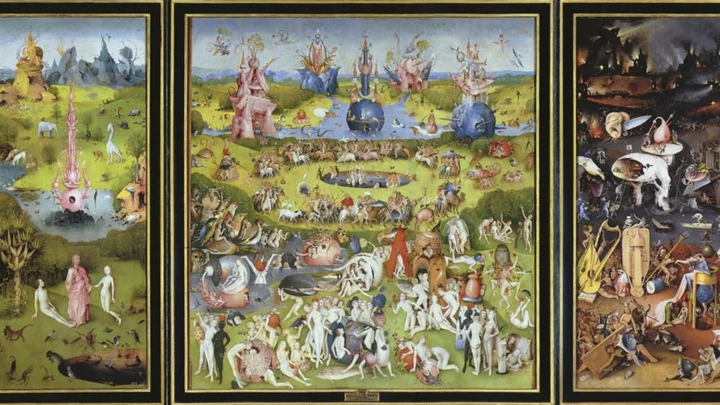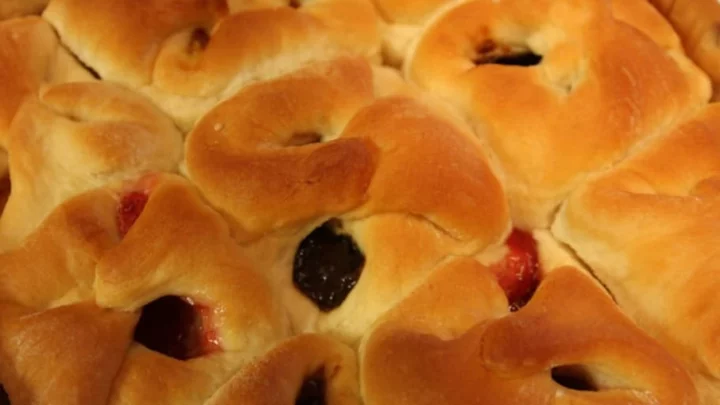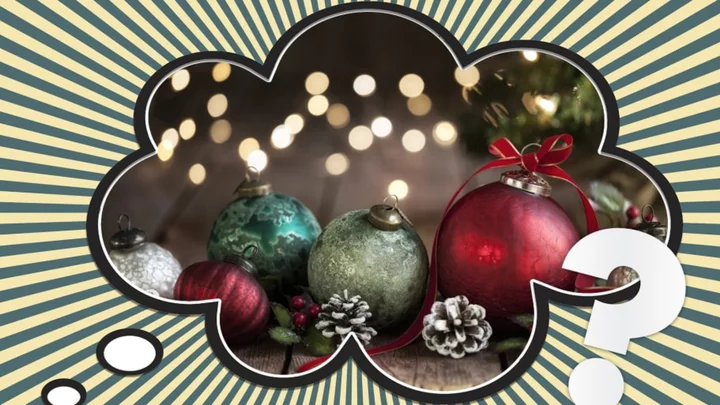The art of Dutch painter Hieronymus Bosch is known for fantastic imagery and delicate details. But none is as ambitious as The Garden of Earthly Delights, a piece so ripe with symbolism that it still inspires intense curiosity more than 500 years after it was painted. Here’s what you should know.
1. The Garden of Earthly Delights is a triptych named for its central panel.
Bosch attempted to depict the whole of human experience from life to afterlife in three related canvases. The first on the left is meant to represent paradise; the last on the right is hell, and in the center lies The Garden of Earthly Delights.
2. The date of its creation is up for debate.
Bosch never dated his pieces, which makes art historians’ jobs a little trickier. Some suggest that Bosch began The Garden of Earthly Delights in 1490, when he would have been about 40 years old. (His exact birth year is unknown, but is assumed to be around 1450.) The piece has been estimated to have been completed sometime between 1510 and 1515.
3. The Garden of Earthly Delights depicts paradise at a significant moment.
The unspoiled landscape populated with curious creatures (including a unicorn) is the Garden of Eden at the very moment Eve was created to be Adam’s companion, according to the Bible’s Book of Genesis. God can be seen making the introduction.
4. Bosch may have included a damning message.
Some art historians believe the middle panel is meant to represent mankind gone mad for sin, wasting its chance at eternity in heaven. The lust Bosch loathed is clear with the barrage of nude figures engaging in frivolity. It’s believed the flowers and fruits are meant to represent short-lived pleasures of the flesh. Some have even suggested that the glass sphere that encompasses some canoodling lovers might be meant to recall the Flemish saying, “Happiness is like glass, it soon breaks.”
5. Some believe the painting depicts paradise lost.
That interpretation is the other popular reading of the triptych: No warning, just a statement that humankind has lost its way. This reading looks at the panels as being seen sequentially left to right, rather than seeing the central panel as a sort of fork in the road leading either left (heaven) or right (hell).
6. There’s more to the painting than its front panels.
Painted on oak, the backs of the paradise and hell panels can be closed to reveal the piece’s final element. There, Bosch is believed to have rendered the third day of God’s creation of the world, when plants had been made but not yet animals or man. It’s topped off with two inscriptions: “He himself said it, and all was done” and “He himself ordered it and all was created.”
Meant as an introduction to the inner panels, these shutters were painted in a monochrome depiction known as grisaille, a common technique for triptych doors of the era so as not to distract from the colors of the opened piece.
7. It is one of three similar triptychs Bosch completed.
Bosch also painted the similarly themed The Last Judgment and The Haywain Triptych. Each one can be read chronologically left to right, from the Bible’s tale of humankind’s creation in the Garden of Eden, to modern man making a mess of the world God made for him, to the horrible hellscapes created by this behavior.
8. Bosch acquired the devotion and vocation needed to create The Garden of Earthly Delights from his father.
Little is known about the life of this Early Netherlandish Renaissance artist, but we do know that his father and grandfather were also both painters. Antonius van Aken, Bosch’s father, was also an adviser to the Illustrious Brotherhood of Our Blessed Lady, a group of Christians dedicated to glorifying the Virgin Mary. Not long before Bosch began work on The Garden of Earthly Delights, he followed his father’s lead and joined the Brotherhood as well.
9. Though it has a religious theme, it probably wasn’t painted for a church.
Its message may have been one of morality and chastity, but the imagery of The Garden of Earthly Delights was just too weird to be displayed in a house of worship. It’s far more likely that the work was a commission for a wealthy patron, possibly a member of the Illustrious Brotherhood of Our Blessed Lady.
10. It may have been a hit in its time.
The Garden of Earthly Delights entered the historical record in 1517, when Italian chronicler Antonio de Beatis probably noted seeing it in a Brussels palace that belonged to the counts of Nassau. He didn’t include the critical reception of the piece, but the fact that reproductions were made, including a painting and a tapestry, suggests that Bosch’s bawdy and bizarre take on damnation found an audience.
11. Mankind’s corruption of God’s word is depicted with two hands.
The first is shown in paradise as a gently raised right hand as God introduces Eve to Adam. In the hell panel, a hand mimicking this position is shown severed, grey with decay and stabbed through its center, with a gambling die perched on its fingers, in Hell’s lower left side on a blue disc. Its message is cruel, but clear.
12. Its colors are believed to be thematic.
Pink symbolizes divinity, as both God (in the first panel) and the fountain of life behind him are radiant with the warm hue. Blue is meant to represent the Earth, and by extension its pleasures, like blue berries to relish, blue casks to guzzle from, blue ponds to frolic in, and creatures to frolic with. Red represents passion. Earth tones represent the mind: the darker its brown hues get, the more irredeemable man has become. Lastly, lime green, radiant in the first panel, is nearly completely absent from the last, supporting the theory that it represents goodness.
13. The Garden of Earthly Delights is probably bigger than you think.
With all that detail, you’d expect it to be big. But The Garden of Early Delights is really big. Its central panel measures about 7.25 feet by 6.5 feet, while each side panel comes in at about 7.25 feet by 3.25 feet, meaning that when the panels are open, this piece is nearly 13 feet wide.
14. Bosch may make a cameo in the piece.
It’s not a flattering self-portrait, but art historian Hans Belting has theorized that Bosch placed himself in the hell panel, split in two. According to this interpretation, the artist is the man whose torso resembles a cracked eggshell, his face turned back smirking on this dark scene. Or as Belting described it, the face has an “expression of irony and the slightly sideways gaze [which would] then constitute the signature of an artist who claimed a bizarre pictorial world for his own personal imagination.”
15. The Garden of Earthly Delights earned Bosch a place as a pioneering surrealist.
Surrealism didn’t spring onto the scene until the 1920s with the rise of Bosch-admirer Salvador Dalí, but Bosch’s jarring juxtapositions and head-scratching symbols have caused some modern critics to call him the world’s first Surrealist—400 years before Dalí.
A version of this story ran in 2015; it has been updated for 2023.
This article was originally published on www.mentalfloss.com as 15 Fascinating Facts About Hieronymus Bosch’s ‘The Garden of Earthly Delights’.









